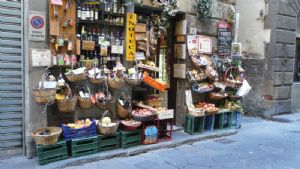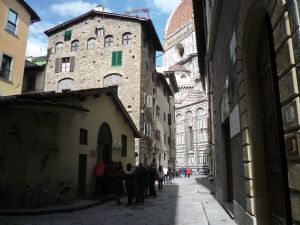It
is just before noon on a bright and clear Wednesday afternoon, and I am on the
hunt for a new street. Crossing Piazza della Repubblica with five potentials
scrawled on an index card, I suddenly realize I need lunch-and fast. I have
only so much time, so I need a spot quick and delicious. I know just the place:
the panino/wine bar in the wall, I Fratellini (38/r), on via dei
Cimatori.
I stand on the
sidewalk, munching a panino oiled lightly with peppers, pickles, and a
thin slice of eggplant. The sounds of Italian, American, French accents cascade
around me as tourists and locals alike huddle in front of the menus. As I move
aside from the growing crowd, I look up and notice on the wall across the
street a small sculpture inlaid in the wall. It appears to be a strange combination
of horse and bird. Someone at some point wanted to make sure that this
particular fragment of the underlying layer of wall was left exposed.
This is just the
kind of thing that sparks my curiosity about a street.
The noon bells from
Chiesa di Orsanmichele peal as I step away from the crowd and wander,
forgetting about my list of other streets. Orsanmichele’s bells sound so much
crisper and tinnier than those of the Duomo down the street. The Duomo’s are
more muffled, but they plod on past the time when Orsanmichele’s have stopped.
The outer layer of
this street is its overt appeal to tourists. It is, after all, two short blocks
away from Piazza della Signoria. The shop
next door to I Fratellini sells ‘Original Florentine Ceramics Our Production‘
(34/r). Perched outside is a chair and miniature work table so passersby can
watch the artisan at work. Across the street is a t-shirt shop (Florence Curiosity
Shop, 23/r), with a colorful display of every soccer jersey imaginable. A trattoria has a blatantly English menu, and a minimarket offers ‘Cold drinks and
snacks.’ Inside the large window of Leonardo Shoes (17/r), a man adjusts the
shoe display. A sign reads, ‘Offering Student Prices.’ The merchants know their
audience well.
Artisanal
work is connected to the name of this street. Cimatori, as Mark Roberts
clarifies in his Street-Names of Florence, refers to the cloth cutters who
once worked on this street. These artisans were famous for their finishing work
on the cloth that the famous Calimala guild, the Arte di Calimala (‘dressers
and dryers of foreign cloth’), exported.
Continuing
toward via dei Magazzini, the street’s end, I spot a short alley, the vicolo
(‘alley’) de’ Cerchi. The Cerchi were a wealthy family who lived here in the
fourteenth century. I can’t enter the alley because of renovation work, but I
can see the grand stone façade of the building on the right-Roberts tells me
that this palazzo was used by the Priors before Palazzo Vecchio was built.
Not
too far down the street Cimatori intersects with via de’ Cerchi. On the
northwest side is the Tower dei Galigai, built between the twelfth and
thirteenth centuries. The powerful Galigai family was known for its expertise
in tanning leather. Dante even mentions a member of the family in his La
Divina Commedia (Puccio de’ Galigai in the Inferno).
The
Tabernacolo del Canto alla Quarquonia, a seventeenth-century fresco, ‘St.
Phillip Neri with the Urchins’ by Alessandra Gherardini, adorns the northeast
corner. The fresco contains a once-illuminated wrought-iron cross that would
signal to passersby that there was an orphanage here, the Pia Casa del Rifugio.
On
the southeast corner, a bricked–up façade hides a beautiful loggia, according to
Roberts. You can still see, however, the engraving in the corner wall that says
‘Loggia dei Cerchi.’
Moving on, I arrive at the Piazza dei
Cerchi. On the western edge
is a shop offering audio walking tours (Audio Guide, 9/r). It also happens to
have a gorgeous brick arched doorway and doubles as an art gallery. The Taverna
Divina Commedia brightens the east corner with its warm red sign and welcoming
curtains behind the door. A tourist couple walks up to the menu standing on an
easel just outside.
Besides this, there
doesn’t seem to be much going on at Piazza dei Cerchi. The graffitied metal
doors of Bizzarri and a leather-goods store-again, with English in its sign-are
the shops that face the street. I wander deeper into the piazza and notice in
the corner a very attractive entryway that appears to be an office. I see two
people working at a desk, lit by a little lamp. I start to walk away but as I
turn I spot an enchanting colorful mural inside. Ah, a gallery! I try the door
but it’s locked. The woman leaning over the desk looks up. She is tall,
elegantly dressed, and beautiful. She greets me with a smile and tells me I’m
welcome to come in.
I
spend the next half an hour or more talking with general manager Yaya Gatti
(the tall, elegant woman) and owner Stefano Conte of CAMI Arte (via della
Condotta, 36/r). They very kindly explain my error in entering through the
piazza; the proper entrance is on via della Condotta. But no matter, Stefano is
happy to personally show me their exhibit. There are sixteenth-century
religious paintings alongside contemporary portraits, landscapes, and as well
as a fresco. An American is being featured, Marc Dalessio, whose visits to
Florence have inspired his landscapes. As much as I tend to favor uncovering
the old Florence, I’m encouraged by this. This mix of worlds instantly appeals to
me, as does the fact that I am sitting here, afterwards, in their office chair
chatting away comfortably about art and Florence to near strangers. They ask me
to stay for coffee, but I’m running out of time, so I tell them I will
certainly be back.
I
continue making my way down Cimatori, and am struck by the stark decay of the
Supercinema (6/r). Its doors are splattered with graffiti and the wall behind
the sign is so cracked you can see a layer of grey underneath the mustard
paint. And yet, something elegant remains: above the doors hangs a
frosted glass canopy attached by wrought-iron brackets and, somehow, delicate
bursts of green fern dangle over the edge of the glass.
Sometimes I get
carried away wanting to find the hidden Florence; I make the mistake that what
is ancient carries more weight, just by the fact that it seems more secret. A
medieval sculpture subtly revealed in a wall can inspire a walk where I
deliberately pay attention. But maybe life is better spent not only diving into
dusty secrets, but giving equal weight to what is charged with life now. The
lively conversation at the gallery, the green ferns over the dilapidated
theater, and the chatty crowds at I Fratellini may leave no record of its
existence, yet they are just as much the ‘real’ Florence as any medieval tower.







